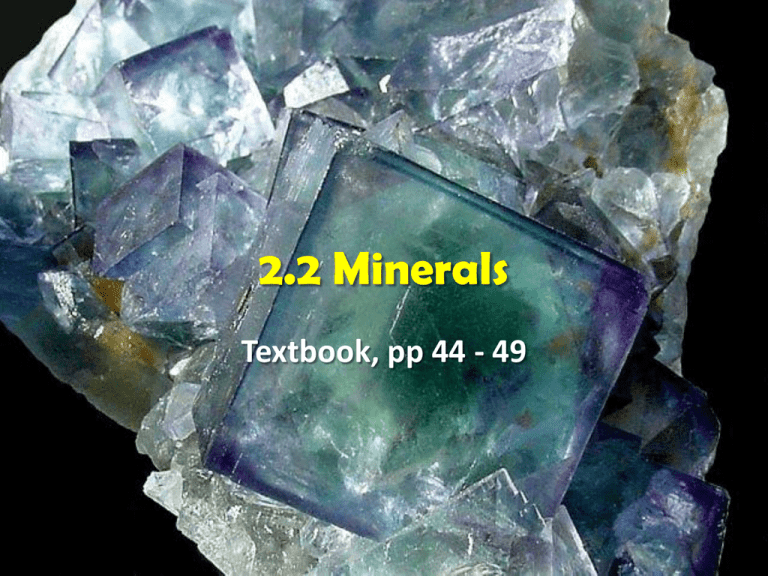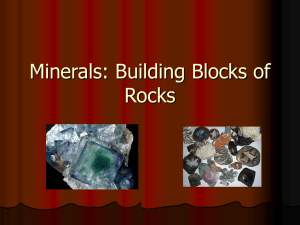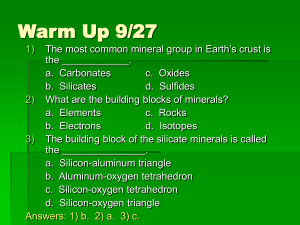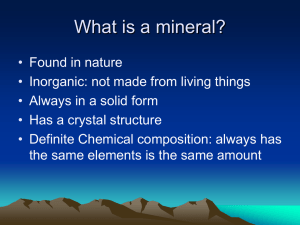2_2 Minerals
advertisement

2.2 Minerals Textbook, pp 44 - 49 Minerals • A mineral is…..naturally occurring. A mineral forms by natural geologic processes. • A mineral is… a solid substance. Minerals are solids within the temperature ranges that are normal for Earth’s surface. A mineral has... an orderly crystalline structure. Minerals have their atoms arranged in an orderly and repetitive manner. A mineral has… a definite chemical composition. Most minerals are chemical compounds made of two or more elements. • A mineral is… generally considered inorganic. Minerals are not generally produced by living creatures. • (An exception to the “inorganic” rule is calcium carbonate, which many marine animals secrete to build their shells.) Quick Question • Can you name three things in this room made from the mineral quartz that was ground up, melted and then cooled? How Minerals Form – Four Major Processes 1. Crystallization from magma. • When magma cools, elements combine to form minerals. Quartz Horneblende 2. Precipitation • When water evaporates, some of the dissolved substances can react to form minerals. Minerals are left behind, or precipitated, out of the water. Halite Calcite 3. Pressure and Temperature • Some minerals form when existing minerals are subjected to changes in pressure and temperature. Their atoms are “re-arranged” by pressure, or are re-stabilized into new minerals by heat. Talc Muscovite 4. Hydrothermal Solutions • A hydrothermal solution is a very hot mixture of water (100°C to 300°C) and dissolved substances. When these solutions come into contact with existing minerals, chemical reactions take place to form new minerals. Bornite Chalcopyrite Quick Question • What is the official mineral for the state of California? GOLD Mineral Groups • Over 3,800 minerals have been named, and several new ones are identified each year. Common minerals, together with the thousand of others that form on Earth, can be classified into groups based on their composition. Jasper and Agate Pebbles, Oregon Coast http://gingerbreadsnowflakes. com/archive/200901 Silicates • The two most abundant elements in Earth’s crust are silicon and oxygen. Quartz, the most common mineral. • Silicon and oxygen combine to form a structure called the silicon-oxygen tetrahedron. Basic Crystal Shapes • Silicon-oxygen tetrahedra can join in a variety of ways. The silicon-oxygen bonds are very strong. Carbonates • Carbonates are minerals that contain the elements carbon, oxygen and one or more other metallic elements. • Calcite is the most common carbonate mineral. Oxides Corundum (ruby) is aluminum oxide. • Oxides are minerals that contain oxygen and one or more other elements, which are usually metals. Sulfates and Sulfides • Sulfates and Sulfides are minerals that contain the element sulfur. Sulfates form when mineral-rich waters evaporate. Pyrite (Fool’s Gold) Halides • Halides are minerals that contain a halogen ion plus one or more other elements. Halite (Rock Salt) Native Elements • Native elements are a group of minerals that exist in relatively pure form. Sulfur Silver







